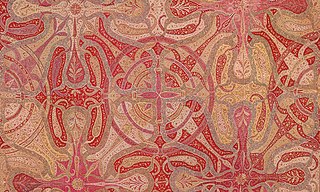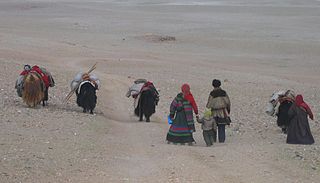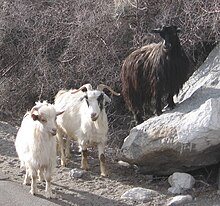
The Angora or Ankara is a Turkish breed of domesticated goat. It produces the lustrous fibre known as mohair. It is widespread in many countries of the world. Many breeds derive from it, among them the Indian Mohair, the Soviet Mohair, the Angora-Don of the Russian Federation and the Pygora in the United States.

Cashmere wool, usually simply known as cashmere, is a fiber obtained from cashmere goats, pashmina goats, and some other breeds of goat. It has been used to make yarn, textiles and clothing for hundreds of years. Cashmere is closely associated with the Kashmir shawl, the word "cashmere" deriving from an anglicization of Kashmir, when the Kashmir shawl reached Europe in the 19th century. Both the soft undercoat and the guard hairs may be used; the softer hair is reserved for textiles, while the coarse guard hair is used for brushes and other non-apparel purposes.

Pashmina refers to, depending on the source, the cashmere wool of the Changthangi cashmere goat, for fine Kashmiri cashmere wool or a synonym for cashmere wool.

A shawl is a simple item of clothing, loosely worn over the shoulders, upper body and arms, and sometimes also over the head. It is usually a rectangular piece of cloth, but can also be square or triangular in shape. Other shapes include oblong shawls. It is associated with the inhabitants of the northern Indian subcontinent—particularly Kashmir and Punjab—and Central Asia, but can be found in many other parts of the world.

Shahtoosh, also known as Shatoush, is a wool obtained from the fur of the chiru. Also, shawls made from the wool of the chiru are called shahtoosh. Shahtoosh is the finest animal wool, followed by vicuña wool.

A cashmere goat is a type of goat that produces cashmere wool, the goat's fine, soft, downy, winter undercoat, in commercial quality and quantity. This undercoat grows as the days get shorter and is associated with an outer coat of coarse hair, which is present all the year and is called guard hair. Most common goat breeds, including dairy goats, grow this two-coated fleece.

The Ladakh Range is a mountain range in central Ladakh in India with its northern tip extending into Baltistan in Pakistan. It lies between the Indus and Shyok river valleys, stretching to 230 miles (370 km). Leh, the capital city of Ladakh, is on the foot of Ladakh Range in the Indus river valley.

The Changtang is a part of the high altitude Tibetan Plateau in western and northern Tibet extending into the southern edges of Xinjiang as well as southeastern Ladakh, India, with vast highlands and giant lakes. From eastern Ladakh, the Changtang stretches approximately 1,600 kilometres (990 mi) east into Tibet as far as modern Qinghai. The Changtang is home to the Changpa, a nomadic Tibetan people. The two largest settlements within the Tibetan Changtang are Rutog Town the seat of Rutog County and Domar Township the seat of Shuanghu County.

Tso Moriri or Lake Moriri or "Mountain Lake", is a lake in the Changthang Plateau in Leh district of the union territory of Ladakh in India. It is located approx. 219 km from Leh City, capital of Ladakh. The lake and surrounding area are protected as the Tso Moriri Wetland Conservation Reserve.

Animal fibers are natural fibers that consist largely of certain proteins. Examples include silk, hair/fur and feathers. The animal fibers used most commonly both in the manufacturing world as well as by the hand spinners are wool from domestic sheep and silk. Also very popular are alpaca fiber and mohair from Angora goats. Unusual fibers such as Angora wool from rabbits and Chiengora from dogs also exist, but are rarely used for mass production.

Korzok, དཀོར་མཛོད་ is a Tibetan Buddhist monastery belonging to the Drukpa Lineage. It is located in the Korzok village, on the northwestern bank of Tso Moriri, a lake in Leh District of Ladakh, a union territory of India. The gompa (monastery), at 4,560 metres (14,960 ft), houses a Shakyamuni Buddha and other statues. It is home to about seventy monks.

The goat or domestic goat is a domesticated species of goat-antelope typically kept as livestock. It was domesticated from the wild goat of Southwest Asia and Eastern Europe. The goat is a member of the animal family Bovidae and the tribe Caprini, meaning it is closely related to the sheep. There are over 300 distinct breeds of goat. It is one of the oldest domesticated species of animal, according to archaeological evidence that its earliest domestication occurred in Iran at 10,000 calibrated calendar years ago.

The Kashmir shawl, the predecessor of the contemporary cashmere shawl, is a type of shawl identified by its distinctive Kashmiri weave and for being made of fine shahtoosh or pashmina wool. Contemporary variants include the pashmina and shahtoosh shawls. In the late 20th century, they evolved to middle-class popularity through generic cashmere products, and raffal, shawls woven in the Kashmiri style, but using thicker Merino wool. Originally designed as a covering for men in India, it has evolved in the popular cultures of India, Europe, and the United States as indicators of nobility and rank, heirlooms giving on a girl's coming-of-age and marriage, and subsequently, as artistic elements in interior design.
The Altai Mountain goat is a breed of domestic goat bred for wool production. The breed was developed during the years from 1944 to 1982 in the Gorno-Altai Autonomous Soviet Socialist Republic region of the Soviet Union, by cross-breeding the Don goat with local goats for a high wool yield.

The Changpa or Champa are a semi-nomadic Tibetan people found mainly in the Changtang in Ladakh, India. A smaller number resides in the western regions of the Tibet Autonomous Region and were partially relocated for the establishment of the Changtang Nature Reserve. As of 1989 there were half a million nomads living in the Changtang area.
Noori was a female pashmina goat, the first pashmina goat to be cloned using the process of nuclear transfer. Born on 9 March 2012, she was kept at the place of her birth, at the Faculty of Veterinary Sciences and Animal Husbandry, Sher-e-Kashmir University of Agricultural Sciences and Technology of Kashmir, Shuhama, Srinagar in the Indian territory of Jammu and Kashmir.
The Aspromonte or Capra dell'Aspromonte is an indigenous breed of domestic goat from the mountain massif of the Aspromonte, in the province of Reggio Calabria in Calabria in southern Italy, for which it is named. It is raised only in the province of Reggio Calabria, mainly in the Aspromonte, in the Altipiano dello Zomaro to the north-east, and in the Ionian coastal areas of the province, and particularly in areas of Grecanic culture. While the breed is thought to originate on the Aspromonte, it may have been influenced by the various other goat breeds, including the Abyssinian goat, the Maltese, and a type known as "Tibetan" with long silky hair, whose importation to Calabria in the early twentieth century is well documented.
Yak fiber is the term commonly used to refer yak fiber wool produced from the coat hair of yaks, a long-haired bovine mainly found in the Himalayan region, Tibetan plateau, and some areas of Mongolia and Central Asia.

Goat farming involves the raising and breeding of domestic goats as a branch of animal husbandry. People farm goats principally for their meat, milk, fibre and skins.
Pashmina is the fine variant of spun cashmere wool.

















